Peat-Forming Environments and Evolution of Thick Coal Seam in Shengli Coalfield, China: Evidence from Geochemistry, Coal Petrology, and Palynology
Abstract
:1. Introduction
2. Geological Setting
3. Materials and Methods
4. Results
4.1. Proximate Analyses and Coal Geochemistry
4.2. Coal Petrology
4.3. Palynology
5. Discussion
5.1. Depositional Environment of the Peat
5.2. Interpretation of Sulfur Enrichment
5.3. Vertical Evolution of Climate and Coal Deposition
5.3.1. Vertical Evolution of Climate
5.3.2. Vertical Evolution of the Peat Environment
6. Conclusions
Acknowledgments
Author Contributions
Conflicts of Interest
References
- Cheng, A.; Cao, D.; Yuan, T.; Shao, L.; Song, H.; Tang, Y.; Ning, S.; Ma, S.; Zhang, G.; Wang, J. Evaluation of Coal Resource in China; China National Administration of Coal Geology: Beijing, China, 2013; p. 728. [Google Scholar]
- Dai, S.; Hou, X.; Ren, D.; Tang, Y. Surface Analysis of Pyrite in the No. 9 Coal Seam, Wuda Coalfield, Inner Mongolia, China, Using High-resolution Time-of-flight Secondary Ion Mass-spectrometry. Int. J. Coal Geol. 2003, 55, 139–150. [Google Scholar] [CrossRef]
- Teichmüller, M. The genesis of coal from the viewpoint of coal petrology. Int. J. Coal Geol. 1989, 12, 1–87. [Google Scholar] [CrossRef]
- Marchioni, D. Petrography and Depositional Environment of the Liddell Seam, Upper Hunter Valley, New South Wales. Int. J. Coal Geol. 1980, 1, 35–61. [Google Scholar] [CrossRef]
- Diessel, C. On the Correlation between Coal Facies and Depositional Environments. In Proceedings of the 20th Newcastle Symposium on “Advances in the Study of the Sydney Basin”; Department of Geology, University of Newcastle: Newcastle, Australia, 1986; pp. 19–22. [Google Scholar]
- Diessel, C.F. Coal-Bearing Depositional Systems; Springer Science & Business Media: New Delhi, India, 2012; pp. 1–579. [Google Scholar]
- Calder, J.H.; Gibling, M.R.; Mukhopadhyay, P.K. Peat Formation in a Westphalian B Piedmont Setting, Cumberland Basin, Nova Scotia: Implications for the Maceral-based Interpretation of Rheotrophic and Raised Paleomires. Bull. Soc. Géol. Fr. 1991, 162, 283–298. [Google Scholar]
- Kalkreuth, W.; Kotis, T.; Papanicolaou, C.; Kokkinakis, P. The Geology and Coal Petrology of a Miocene Lignite Profile at Meliadi Mine, Katerini, Greece. Int. J. Coal Geol. 1991, 17, 51–67. [Google Scholar] [CrossRef]
- Kalaitzidis, S.; Bouzinos, A.; Papazisimou, S.; Christanis, K. A Short-Term Establishment of Forest Fen Habitat during Pliocene Lignite Formation in the Ptolemais Basin, Nw Macedonia, Greece. Int. J. Coal Geol. 2004, 57, 243–263. [Google Scholar] [CrossRef]
- Staub, J.R. Marine Flooding Events and Coal Bed Sequence Architecture in Southern West Virginia. Int. J. Coal Geol. 2002, 49, 123–145. [Google Scholar] [CrossRef]
- Petersen, H.I.; Ratanasthien, B. Coal Facies in a Cenozoic Paralic Lignite Bed, Krabi Basin, Southern Thailand: Changing Peat-Forming Conditions Related to Relative Sea-Level Controlled Watertable Variations. Int. J. Coal Geol. 2011, 87, 2–12. [Google Scholar] [CrossRef]
- Crosdale, P.J. Coal Maceral Ratios as Indicators of Environment of Deposition: Do They Work for Ombrogenous Mires? An Example from the Miocene of New Zealand. Org. Geochem. 1993, 20, 797–809. [Google Scholar] [CrossRef]
- Moore, T.A.; Shearer, J.C. Peat/Coal Type and Depositional Environment—Are They Related? Int. J. Coal Geol. 2003, 56, 233–252. [Google Scholar] [CrossRef]
- Scott, A.C. Coal Petrology and the Origin of Coal Macerals: A Way Ahead? Int. J. Coal Geol. 2002, 50, 119–134. [Google Scholar] [CrossRef]
- Wüst, R.A.J.; Hawke, M.I.; Marc Bustin, R. Comparing Maceral Ratios from Tropical Peatlands with Assumptions from Coal Studies: Do Classic Coal Petrographic Interpretation Methods Have to Be Discarded? Int. J. Coal Geol. 2001, 48, 115–132. [Google Scholar] [CrossRef]
- Çelik, Y.; Karayiğit, A.İ.; Querol, X.; Oskay, R.G.; Mastalerz, M.; Kayseri Özer, M.S. Coal Characteristics, Palynology, and Palaeoenvironmental Interpretation of the Yeniköy Coal of Late Oligocene Age in the Thrace Basin (NW Turkey). Int. J. Coal Geol. 2017, 181, 103–123. [Google Scholar] [CrossRef]
- Jasper, K.; Hartkopf-Fröder, C.; Flajs, G.; Littke, R. Evolution of Pennsylvanian (Late Carboniferous) Peat Swamps of the Ruhr Basin, Germany: Comparison of Palynological, Coal Petrographical and Organic Geochemical Data. Int. J. Coal Geol. 2010, 83, 346–365. [Google Scholar] [CrossRef]
- Karayiğit, A.I.; Oskay, R.G.; Christanis, K.; Tunoğlu, C.; Tuncer, A.; Bulut, Y. Palaeoenvironmental Reconstruction of the Çardak Coal Seam, SW Turkey. Int. J. Coal Geol. 2015, 139, 3–16. [Google Scholar] [CrossRef]
- Karayiğit, A.I.; Bircan, C.; Mastalerz, M.; Oskay, R.G.; Querol, X.; Lieberman, N.R.; Türkmen, I. Coal Characteristics, Elemental Composition and Modes of Occurrence of Some Elements in the Isaalan Coal (Balikesir, NW Turkey). Int. J. Coal Geol. 2017, 172, 43–59. [Google Scholar] [CrossRef]
- Karayiğit, A.İ.; Littke, R.; Querol, X.; Jones, T.; Oskay, R.G.; Christanis, K. The Miocene Coal Seams in the Soma Basin (W Turkey): Insights from Coal Petrography, Mineralogy and Geochemistry. Int. J. Coal Geol. 2017, 173, 110–128. [Google Scholar] [CrossRef]
- Mitrović, D.; Đoković, N.; Životić, D.; Bechtel, A.; Šajnović, A.; Stojanović, K. Petrographical and Organic Geochemical Study of the Kovin Lignite Deposit, Serbia. Int. J. Coal Geol. 2016, 168, 80–107. [Google Scholar] [CrossRef]
- Zdravkov, A.; Bechtel, A.; Sachsenhofer, R.F.; Kortenski, J.; Gratzer, R. Vegetation Differences and Diagenetic Changes between Two Bulgarian Lignite Deposits–Insights from Coal Petrology and Biomarker Composition. Org. Geochem. 2011, 42, 237–254. [Google Scholar] [CrossRef]
- Saiki, K.I.; Wang, Y.-D. Preliminary Analysis of Climate Indicator Plant Distribution in the Early Cretaceous of China. J. Asian Earth Sci. 2003, 21, 813–822. [Google Scholar] [CrossRef]
- Zhang, M.; Dai, S.; Heimhofer, U.; Wu, M.; Wang, Z.; Pan, B. Palynological Records from Two Cores in the Gongpoquan Basin, Central East Asia: Evidence for Floristic and Climatic Change during the Late Jurassic to Early Cretaceous. Rev. Palaeobot. Palynol. 2014, 204, 1–17. [Google Scholar] [CrossRef]
- Eble, C.F.; Grady, W.C.; Blake, B.M. Dunkard Group Coal Beds: Palynology, Coal Petrography and Geochemistry. Int. J. Coal Geol. 2013, 119, 32–40. [Google Scholar] [CrossRef]
- Caratini, C.; Tissot, C. Paleogeographical Evolution of the Mahakam Delta in Kalimantan, Indonesia during the Quaternary and Late Pliocene. Rev. Palaeobot. Palynol. 1988, 55, 217–228. [Google Scholar] [CrossRef]
- Na, Y.; Manchester, S.R.; Sun, C.; Zhang, S. The Middle Jurassic Palynology of the Daohugou Area, Inner Mongolia, China, and Its Implications for Palaeobiology and Palaeogeography. Palynology 2015, 39, 270–287. [Google Scholar] [CrossRef]
- Dai, S.; Wang, X.; Seredin, V.V.; Hower, J.C.; Ward, C.R.; O’Keefe, J.M.K.; Huang, W.; Li, T.; Li, X.; Liu, H.; et al. Petrology, Mineralogy, and Geochemistry of the Ge-Rich Coal From The Wulantuga Ge Ore Deposit, Inner Mongolia, China: New Data and Genetic Implications. Int. J. Coal Geol. 2012, 90–91, 72–99. [Google Scholar] [CrossRef]
- Wang, S.; Shao, L.; Sun, Q.; Wang, D.; Lu, J.; Sun, B. Sequence and Coal Accumulation of the Lower Cretaceous Saihantala Formation in Jiergalangtu Sag of Erlian Basin. J. Palaeogeogr. 2015, 17, 393–404, (In Chinese with English Abstract). [Google Scholar]
- Wu, X.; Wu, C.; Mao, X.; Zhang, J. Analysis on Sedimentary Characteristics and Allochthonous Genesis of Extra-Thick Seam Jin Jiergalangtu Depression, Saihantala Formation. Acta Sedimentol. Sin. 2016, 34, 1155–1164, (In Chinese with English Abstract). [Google Scholar]
- Lin, C.; Kenneth, E.; Li, S.; Wan, Y.; Ren, J.; Zhang, Y. Sequence Architecture, Depositional systems, and Controls on Development of Lacustrine Basin Fills in Part of the Erlian Basin, Northeast China. AAPG Bull. 2001, 85, 2017–2043. [Google Scholar]
- Zhang, W. Sedimentary Facies and Hydrocarbon-bearing of Lower Cretaceous Strata in Erlian Basin. Sci. Geol. Sin. 1998, 33, 204–213, (In Chinese with English Abstract). [Google Scholar]
- Zhuang, X.; Querol, X.; Alastuey, A.; Juan, R.; Plana, F.; Lopez-Soler, A.; Du, G.; Martynov, V.V. Geochemistry and Mineralogy of the Cretaceous Wulantuga High-Germanium Coal Deposit in Shengli Coal Field, Inner Mongolia, Northeastern China. Int. J. Coal Geol. 2006, 66, 119–136. [Google Scholar] [CrossRef]
- Qi, H.; Hu, R.; Zhang, Q. Ree Geochemistry of the Cretaceous Lignite from Wulantuga Germanium Deposit, Inner Mongolia, Northeastern China. Int. J. Coal Geol. 2007, 71, 329–344. [Google Scholar] [CrossRef]
- Qi, H.; Hu, R.; Zhang, Q. Concentration and Distribution of Trace Elements in Lignite from the Shengli Coalfield, Inner Mongolia, China: Implications on Origin of the Associated Wulantuga Germanium Deposit. Int. J. Coal Geol 2007, 71, 129–152. [Google Scholar] [CrossRef]
- Du, G.; Zhuang, X.; Querol, X.; Izquierdo, M.; Alastuey, A.; Moreno, T.; Font, O. Ge Distribution in the Wulantuga High-Germanium Coal Deposit In The Shengli Coalfield, Inner Mongolia, Northeastern China. Int. J. Coal Geol. 2009, 78, 16–26. [Google Scholar] [CrossRef]
- Dai, S.; Liu, J.; Ward, C.R.; Hower, J.C.; Xie, P.; Jiang, Y.; Hood, M.M.; O’Keefe, J.M.K.; Song, H. Petrological, Geochemical, and Mineralogical Compositions of the Low-Ge Coals from the Shengli Coalfield, China: A Comparative Study with Ge-Rich Coals and a Formation Model for Coal-Hosted Ge Ore Deposit. Ore Geol. Rev. 2015, 71, 318–349. [Google Scholar] [CrossRef]
- Dai, S.; Yan, X.; Ward, C.R.; Hower, J.C.; Zhao, L.; Wang, X.; Zhao, L.; Ren, D.; Finkelman, R.B. Valuable Elements in Chinese Coals: A Review. Int. Geol. Rev. 2016, 1–31. [Google Scholar] [CrossRef]
- Kolker, A.; Scott, C.; Hower, J.C.; Vazquez, J.A.; Lopano, C.L.; Dai, S. Distribution of Rare Earth Elements in Coal Combustion Fly Ash, Determined by Shrimp-Rg Ion Microprobe. Int. J. Coal Geol. 2017, 184, 1–10. [Google Scholar] [CrossRef]
- Dai, S.; Finkelman, R.B. Coal as a Promising Source of Critical Elements: Progress and Future Prospects. Int. J. Coal Geol. 2018, 186, 155–164. [Google Scholar] [CrossRef]
- Seredin, V.V.; Dai, S. Coal Deposits as Potential Alternative Sources for Lanthanides and Yttrium. Int. J. Coal Geol. 2012, 94, 67–93. [Google Scholar] [CrossRef]
- Hower, J.C.; Granite, E.J.; Mayfield, D.B.; Lewis, A.S.; Finkelman, R.B. Notes on Contributions to the Science of Rare Earth Element Enrichment in Coal and Coal Combustion Byproducts. Minerals 2016, 6, 32. [Google Scholar] [CrossRef]
- Hower, J.C.; Groppo, J.G.; Henke, K.R.; Hood, M.M.; Eble, C.F.; Honaker, R.Q.; Zhang, W.; Qian, D. Notes on the Potential for the Concentration of Rare Earth Elements and Yttrium in Coal Combustion Fly Ash. Minerals 2015, 5, 356–366. [Google Scholar] [CrossRef]
- Fan, X.; Nie, F.; Chen, Y.; Wang, W. Discussion on Age and Paleo Geographical Environment of Ore Bearing Strata for Sandstone-Type Uranium Deposits in Bayanwula Area, Erlian Basin. Uranium Geol. 2008, 24, 150–154. [Google Scholar]
- Scotese, C.R. Paleomap Project. Available online: http://www.scotese.com/ecretcli.htm (accessed on 8 February 2018).
- Cheng, J.; Shang, Y. Early Cretaceous Palynological Assemblage Sequence and Palaeoclimate Research in Zhalainuoer Coalmine, Manzhouli, Inner Mongolia. Acta Palaeontol. Sin. 2015, 54, 316–341, (In Chinese with English Abstract). [Google Scholar]
- Wang, D.; Shao, L.; Zhang, Q.; Ding, F.; Li, Z.; Zhang, W. Analysis of Coal-accumulating Characteristics in the Lower Cretaceous Coal-Containing Strata of the Erlian Basin Group. J. China Univ. Min. Technol. 2013, 42, 257–265, (In Chinese with English Abstract). [Google Scholar]
- Bonnetti, C.; Malartre, F.; Huault, V.; Cuney, M.; Bourlange, S.; Liu, X.; Peng, Y. Sedimentology, Stratigraphy and Palynological Occurrences of the Late Cretaceous Erlian Formation, Erlian Basin, Inner Mongolia, People’s Republic of China. Cretac. Res. 2014, 48, 177–192. [Google Scholar] [CrossRef]
- Wu, G.; Sun, F.; Zhao, C.; Li, Z.; Zhao, A.; Pang, Q.; Li, G. Discovery of the Early Paleozoic Post-collisional Granites in Northern Margin of the Erguna Massif and Its Geological Significance. Chin. Sci. Bull. 2005, 50, 2733–2743. [Google Scholar] [CrossRef]
- Ying, J.; Zhou, X.; Zhang, L.; Wang, F. Geochronological Framework of Mesozoic Volcanic Rocks in the Great Xing’an Range, Ne China, and Their Geodynamic Implications. J. Asian Earth Sci. 2010, 39, 786–793. [Google Scholar] [CrossRef]
- Graham, S.; Hendrix, M.; Johnson, C.; Badamgarav, D.; Badarch, G.; Amory, J.; Porter, M.; Barsbold, R.; Webb, L.; Hacker, B. Sedimentary Record and Tectonic Implications of Mesozoic Rifting in Southeast Mongolia. Geol. Soc. Am. Bull. 2001, 113, 1560–1579. [Google Scholar] [CrossRef]
- Sun, B.; Shao, L.; Zhao, Q.; Li, W.; Chen, G. Evaluation of Coalbed Gas Exploration Target in Erlian Basin. Coal. Geol. Explor. 2008, 36, 22–26, (In Chinese with English Abstract). [Google Scholar]
- Dai, S.; Ren, D.; Chou, C.-L.; Finkelman, R.B.; Seredin, V.V.; Zhou, Y. Geochemistry of Trace Elements in Chinese Coals: A Review of Abundances, Genetic Types, Impacts on Human Health, and Industrial Utilization. Int. J. Coal Geol. 2012, 94, 3–21. [Google Scholar] [CrossRef]
- Dai, S.; Wang, P.; Ward, C.R.; Tang, Y.; Song, X.; Jiang, J.; Hower, J.C.; Li, T.; Seredin, V.V.; Wagner, N.J.; et al. Elemental and Mineralogical Anomalies in the Coal-hosted Ge Ore Deposit of Lincang, Yunnan, Southwestern China: Key Role of N2–CO2-mixed Hydrothermal Solutions. Int. J. Coal Geol. 2015, 152, 19–46. [Google Scholar] [CrossRef]
- Li, W.; Liu, Z. The Cretaceous Palynofloras and Their Bearing on Stratigraphic Correlation in China. Cretac. Res. 1994, 15, 333–365. [Google Scholar] [CrossRef]
- Mukhopadhyay, P.K. Organic Petrography and Organic Geochemistry of Texas Tertiary Coals in Relation to Depositional Environment and Hydrocarbon Generation; Bureau of Economic Geology: Austin, TX, USA, 1989. [Google Scholar]
- Oskay, R.G.; Christanis, K.; Inaner, H.; Salman, M.; Taka, M. Palaeoenvironmental Reconstruction of the Eastern Part of the Karapınar-Ayrancı Coal Deposit (Central Turkey). Int. J. Coal Geol. 2016, 163, 100–111. [Google Scholar] [CrossRef]
- Kalaitzidis, S.; Siavalas, G.; Skarpelis, N.; Araujo, C.V.; Christanis, K. Late Cretaceous Coal Overlying Karstic Bauxite Deposits in the Parnassus-Ghiona Unit, Central Greece: Coal Characteristics and Depositional Environment. Int. J. Coal Geol. 2010, 81, 211–226. [Google Scholar] [CrossRef]
- Li, W.; Tang, Y.; Deng, X.; Yu, X. Geochemistry of the Trace Elements in the High Organic Sulfur Coals from Chenxi Coalfield. J. China Coal Soc. 2013, 38, 1227–1233. [Google Scholar]
- Liu, G.; Yang, P.; Peng, Z.; Wang, G.; Zhang, W. Comparative Study of the Quality of Some Coals from the Zibo Coal Field. Energy 2003, 28, 969–978. [Google Scholar] [CrossRef]
- Cui, G.; Quan, S.; Wu, C. Jurassic Coal in Yanqi Basin (Xinjiang, China): Geochemical Characteristics of Trace Elements and Their Implications. Acta Sci. Nat. Univ. Pekin. 2004, 40, 594–600, (In Chinese with an English Abstract). [Google Scholar]
- Zheng, L.; Liu, G.; Chou, C.; Gao, L.; Peng, Z. Arsenic in Chinese Coals: Its Abundance, Distribution, Modes of Occurrence, Enrichment Processes, and Environmental Significance. Acta Geosci. Sin. 2006, 27, 355–366, (In Chinese with English abstract). [Google Scholar]
- Reimann, C.; De Caritat, P. Chemical Elements in the Environment: Factsheets for the Geochemist and Environmental Scientist; Springer Science & Business Media: New York, NY, USA, 2012; p. 397. [Google Scholar]
- Shao, L.; Jones, T.; Gayer, R.; Dai, S.; Li, S.; Jiang, Y.; Zhang, P. Petrology and Geochemistry of the High-Sulphur Coals from the Upper Permian Carbonate Coal Measures in the Heshan Coalfield, Southern China. Int. J. Coal Geol. 2003, 55, 1–26. [Google Scholar] [CrossRef]
- Dai, S.; Zhang, W.; Seredin, V.V.; Ward, C.R.; Hower, J.C.; Song, W.; Wang, X.; Li, X.; Zhao, L.; Kang, H.; et al. Factors Controlling Geochemical and Mineralogical Compositions of Coals Preserved Within Marine Carbonate Successions: A Case Study from the Heshan Coalfield, Southern China. Int. J. Coal Geol. 2013, 109, 77–100. [Google Scholar] [CrossRef]
- Zhao, S. Reductivity of Humic Coal in China and Its Relation to Sedimentary Environment. Acta Sedimentol. Sin. 1984, 2, 53–65. [Google Scholar]
- Spiker, E.C.; Pierce, B.S.; Bates, A.L.; Stanton, R.W. Isotopic Evidence for the Source of Sulfur in the Upper Freeport Coal Bed (West-Central Pennsylvania, U.S.A.). Chem. Geol. 1994, 114, 115–130. [Google Scholar] [CrossRef]
- Kang, X.; Yang, Q.; Zhang, R.; Zhou, C.; Tang, D.; Liu, D. Occurrence State and Origin of Organic Sulfur in Late Paleozoic Coal, North China. Earth Sci. 1999, 24, 413–417. [Google Scholar]
- Casagrande, D.J. Sulphur in peat and coal. In Coal and Coal-Bearing Strata: Recent Advances; Scott, A.C., Ed.; Geological Society Special Publications: London, UK, 1987; Volume 32, pp. 87–105. [Google Scholar]
- Westgate, L.M.; Anderson, T.F. Isotopic Evidence for the Origin of Sulfur in the Herrin (no. 6) Coal Member of Illinois. Int. J. Coal Geol. 1984, 4, 1–20. [Google Scholar] [CrossRef]
- Smith, J.W.; Batts, B.D. The Distribution and Isotopic Composition of Sulfur in Coal. Geochim. Cosmochim. Acta 1974, 38, 121–133. [Google Scholar] [CrossRef]
- Shimoyama, T.; Yamazaki, K.; Iijima, A. Sulphur Isotopic Composition in the Palaeogene Coal of Japan. Int. J. Coal Geol. 1990, 15, 191–217. [Google Scholar] [CrossRef]
- Price, F.T.; Shieh, Y. The Distribution and Isotopic Composition of Sulfur in Coals from the Illinois Basin. Econ. Geol. 1979, 74, 1445–1461. [Google Scholar] [CrossRef]
- Jiang, Y.; Elswick, E.R.; Mastalerz, M. Progression in Sulfur Isotopic Compositions from Coal to Fly Ash: Examples from Single-Source Combustion in Indiana. Int. J. Coal Geol. 2008, 73, 273–284. [Google Scholar] [CrossRef]
- Hunt, J.; Smith, J. 34S/32S Ratios of Low Sulfur Permian Australian Coals in Relation to Depositional Environments. Chem. Geol. 1985, 58, 137–144. [Google Scholar] [CrossRef]
- Dai, S.; Ren, D.; Tang, Y.; Shao, L.; Li, S. Distribution, Isotopic Variation and Origin of Sulfur in Coals in the Wuda Coalfield, Inner Mongolia, China. Int. J. Coal Geol. 2002, 51, 237–250. [Google Scholar] [CrossRef]
- Lei, J. Sulfur-accumulating Model of Superhigh Organosulfur Coal from Guiding. China. Chin. Sci. Bull. 1994, 39, 1817–1821. [Google Scholar]
- Chou, C.L. Sulfur in coals: A Review of Geochemistry and Origins. Int. J. Coal Geol. 2012, 100, 1–13. [Google Scholar] [CrossRef]
- Williams, E.; Keith, M. Relationship between Sulfur in Coals and the Occurrence of Marine Roof Beds. Int. J. Coal Geol. 1963, 58, 720–729. [Google Scholar] [CrossRef]
- Dai, S.; Ren, D.; Zhou, Y.; Chou, C.L.; Wang, X.; Zhao, L.; Zhu, X. Mineralogy and Geochemistry of a Superhigh-Organic-Sulfur Coal, Yanshan Coalfield, Yunnan, China: Evidence for a Volcanic Ash Component and Influence By Submarine Exhalation. Chem. Geol. 2008, 255, 182–194. [Google Scholar] [CrossRef]
- Gayer, R.A.; Rose, M.; Dehmer, J.; Shao, L.Y. Impact of Sulphur and Trace Element Geochemistry on the Utilization of a Marine-Influenced Coal—Case Study from the South Wales Variscan Foreland Basin. Int. J. Coal Geol. 1999, 40, 151–174. [Google Scholar] [CrossRef]
- Casagrande, D.J.; Siefert, K.; Berschinski, C.; Sutton, N. Sulfur in Peat-Forming Systems of the Okefenokee Swamp and Florida Everglades: Origins of Sulfur in Coal. Geochim. Cosmochim. Acta 1977, 41, 161–167. [Google Scholar] [CrossRef]
- Chou, C.L. Geochemistry of Sulfur in Coal. In Geochemistry of Sulphur in Fossil Fuels; Orr, W.L., White, C.M., Eds.; American Chemical Society Symposium Series: Washington, DC, USA, 1990; pp. 30–52. [Google Scholar]
- Johnson, C.L.; Greene, T.J.; Zinniker, D.A.; Moldowan, J.M.; Hendrix, M.S.; Carroll, A.R. Geochemical Characteristics and Correlation of Oil and Nonmarine Source Rocks from Mongolia. AAPG Bull. 2003, 87, 817–846. [Google Scholar] [CrossRef]
- Bouška, V.; Pešek, J.; Žák, K. Values of δ34S in Iron Disulphides of the North Bohemian Lignite Basin, Czech Republic. In European Coal Geology and Technology; Geological Society Special Publications: London, UK, 1997; Volume 125, pp. 261–267. [Google Scholar]
- Widodo, S.; Oschmann, W.; Bechtel, A.; Sachsenhofer, R.F.; Anggayana, K.; Puettmann, W. Distribution of Sulfur and Pyrite in Coal Seams From Kutai Basin (East Kalimantan, Indonesia): Implications for Paleoenvironmental Conditions. Int. J. Coal Geol. 2010, 81, 151–162. [Google Scholar] [CrossRef]
- Querol, X.; Cabrera, L.; Pickel, W.; López-Soler, A.; Hagemann, H.W.; Fernández-Turiel, J.L. Geological Controls on the Coal Quality of the Mequinenza Subbituminous Coal Deposit, Northeast Spain. Int. J. Coal Geol. 1996, 29, 67–91. [Google Scholar] [CrossRef]
- Bechtel, A.; Reischenbacher, D.; Sachsenhofer, R.F.; Gratzer, R.; Lücke, A.; Püttmann, W. Relations of Petrographical and Geochemical Parameters in the Middle Miocene Lavanttal Lignite (Austria). Int. J. Coal Geol. 2007, 70, 325–349. [Google Scholar] [CrossRef]
- Markic, M.; Sachsenhofer, R.F. Petrographic Composition and Depositional Environments of the Pliocene Velenje Lignite Seam (Slovenia). Int. J. Coal Geol. 1997, 33, 229–254. [Google Scholar] [CrossRef]
- Siavalas, G.; Linou, M.; Chatziapostolou, A.; Kalaitzidis, S.; Papaefthymiou, H.; Christanis, K. Palaeoenvironment of Seam I in the Marathousa Lignite Mine, Megalopolis Basin (Southern Greece). Int. J. Coal Geol. 2009, 78, 233–248. [Google Scholar] [CrossRef]
- Diehl, S.F.; Goldhaber, M.B.; Koenig, A.E.; Lowers, H.A.; Ruppert, L.F. Distribution of Arsenic, Selenium, and Other Trace Elements in High Pyrite Appalachian Coals: Evidence for Multiple Episodes of Pyrite Formation. Int. J. Coal Geol. 2012, 94, 238–249. [Google Scholar] [CrossRef]
- Querol, X.; Whateley, M.K.G.; Fernández-Turiel, J.L.; Tuncali, E. Geological Controls on the Mineralogy and Geochemistry of the Beypazari Lignite, Central Anatolia, Turkey. Int. J. Coal Geol. 1997, 33, 255–271. [Google Scholar] [CrossRef]
- Wang, F.; Zhou, X.-H.; Zhang, L.-C.; Ying, J.-F.; Zhang, Y.-T.; Wu, F.-Y.; Zhu, R.-X. Late Mesozoic Volcanism in the Great Xing’an Range (NE China): Timing and Implications for the Dynamic Setting of NE Asia. Earth Planet. Sci. Lett. 2006, 251, 179–198. [Google Scholar] [CrossRef]
- Guo, F.; Fan, W.; Wang, Y.; Lin, G. Petrogenesis of the Late Mesozoic Bimodal Volcanic Rocks in the Southern Da Hinggan Mts, China. Acta Petrol. Sin. 2001, 17, 161–168, (In Chinese with English Abstract). [Google Scholar]
- Stach, E. Stach’s Textbook of Coal Petrology; Gebruder Borntraeger: Berlin, Germany, 1982. [Google Scholar]
- Lyons, P.C.; Whelan, J.F.; Dulong, F.T. Marine Origin of Pyritic Sulfur in the Lower Bakerstown Coal Bed, Castleman Coal Field, Maryland (U.S.A.). Int. J. Coal Geol. 1989, 12, 329–348. [Google Scholar] [CrossRef]
- Yan, W.; Fan, T.; Wang, H.; Sun, Y.; Yang, F.; Wei, Y.; Hu, X. On the Microfossile Assemblages, Paleoclimate Indicator and Oil-Controlling Significance from the Lower Cretaceous Strata in the Lishu Depression, Songliao Basin, Ne China. Acta Micropalaeontol. Sin. 2014, 31, 175–189, (In Chinese with English Abstract). [Google Scholar]
- Tian, M.; Zhang, M.; Ren, Y.; Qiao, X.; Wan, C.; Liu, P. On The Sporopollen Alga Assemblages and Enviroments from the Third Member of Nanjing Formation in the Xinzhan Area of Songliao Basin. J. Jilin Univ. 2005, 35, 449–455, (In Chinese with English Abstract). [Google Scholar]
- Sha, J. Cretaceous Stratigraphy of Northeast China: Non-marine and Marine Correlation. Cretac. Res. 2007, 28, 146–170. [Google Scholar] [CrossRef]
- Wang, P.; Du, X.; Wang, D. Geochemical Records of the Cretaceous Lacustrine Transgressive sequences and the Marine-lake Connecting Events in the Songliao Basin, Northeast China. Sediment. Facies Paleogeogr. 1995, 15, 14–20, (In Chinese with English Abstract). [Google Scholar]
- Casagrande, D.; Siefert, K. Origins of Sulfur in Coal: Importance of the Ester Sulfate Content of Peat. Science 1977, 195, 675–676. [Google Scholar] [CrossRef] [PubMed]
- Dai, S. The Action and Significance of Low Organism in the Formation of High-Sulfur Coal. Sci. Geol. Sin. 2000, 9, 339–352. [Google Scholar]
- Eldrett, J.S.; Greenwood, D.R.; Harding, I.C.; Huber, M. Increased Seasonality through the Eocene to Oligocene Transition in Northern High Latitudes. Nature 2009, 459, 969–974. [Google Scholar] [CrossRef] [PubMed]
- Chen, Z.; Wang, Z.; Schneiderman, J.; Taol, J.; Cail, Y. Holocene Climate Fluctuations in the Yangtze Delta of Eastern China and the Neolithic Response. Holocene 2005, 15, 915–924. [Google Scholar] [CrossRef]
- Bartlein, P.J.; Harrison, S.P.; Brewer, S.; Connor, S.; Davis, B.A.S.; Gajewski, K.; Guiot, J.; Harrison-Prentice, T.I.; Henderson, A.; Peyron, O.; et al. Pollen-Based Continental Climate Reconstructions at 6 and 21 Ka: A Global Synthesis. Clim. Dyn. 2011, 37, 775–802. [Google Scholar] [CrossRef]
- Akyuz, I.; Warny, S.; Famubode, O.; Bhattacharya, J.P. Palynology of the Upper Cretaceous (Turonian) Ferron Sandstone Member, Utah, Usa: Identification of Marine Flooding Surfaces and Milankovitch Cycles in Subtropical, Ever-Wet, Paralic to Non-Marine Palaeoenvironments. Palynology 2016, 40, 122–136. [Google Scholar] [CrossRef]
- Yang, X.; Li, W.; Batten, D.J. Biostratigraphic and Palaeoenvironmental Implications of an Early Cretaceous Miospore Assemblage from the Muling Formation, Jixi Basin, Northeast China. Cretac. Res. 2007, 28, 339–347. [Google Scholar] [CrossRef]
- Lipp, J.; Trimborn, P.; Fritz, P.; Moser, H.; Becker, B.; Frenzel, B. Stable Isotopes in Tree Ring Cellulose and Climatic Change. Tellus B 1991, 43, 322–330. [Google Scholar] [CrossRef]
- Libby, L.M.; Pandolfi, L.J.; Payton, P.H.; Marshall, J.; Becker, B.; Giertz-Sienbenlist, V. Isotopic Tree Thermometers. Nature 1976, 261, 284–288. [Google Scholar] [CrossRef]
- Pearman, G.; Francey, R.; Fraser, P. Climatic Implications of Stable Carbon Isotopes in Tree Rings. Nature 1976, 260, 771–773. [Google Scholar] [CrossRef]
- Wilson, A.; Grinsted, M. 12c/13c in Cellulose and Lignin as Palaeothermometers. Nature 1977, 265, 133–135. [Google Scholar] [CrossRef]
- Widodo, S.; Bechtel, A.; Anggayana, K.; Püttmann, W. Reconstruction of Floral Changes during Deposition of the Miocene Embalut Coal From Kutai Basin, Mahakam Delta, East Kalimantan, Indonesia by Use of Aromatic Hydrocarbon Composition and Stable Carbon Isotope Ratios of Organic Matter. Org. Geochem. 2009, 40, 206–218. [Google Scholar] [CrossRef]
- Gröcke, D.R.; Hesselbo, S.P.; Jenkyns, H.C. Carbon-isotope Composition of Lower Cretaceous Fossil Wood: Ocean-Atmosphere Chemistry and Relation to Sea-Level Change. Geology 1999, 27, 155–158. [Google Scholar] [CrossRef]
- Murray, A.P.; Edwards, D.; Hope, J.M.; Boreham, C.J.; Booth, W.E.; Alexander, R.A.; Summons, R.E. Carbon Isotope Biogeochemistry of Plant Resins and Derived Hydrocarbons. Org. Geochem. 1998, 29, 1199–1214. [Google Scholar] [CrossRef]
- Lücke, A.; Helle, G.; Schleser, G.H.; Figueiral, I.; Mosbrugger, V.; Jones, T.P.; Rowe, N.P. Environmental History of the German Lower Rhine Embayment during the Middle Miocene as Reflected by Carbon Isotopes in Brown Coal. Palaeogeogr. Palaeoclimatol. Palaeoecol. 1999, 154, 339–352. [Google Scholar] [CrossRef]
- Holdgate, G.; Wallace, M.; O’Connor, M.; Korasidis, V.; Lieven, U. The Origin of Lithotype Cycles in Oligo-Miocene Brown Coals from Australia and Germany. Int. J. Coal Geol. 2016, 166, 47–61. [Google Scholar] [CrossRef]
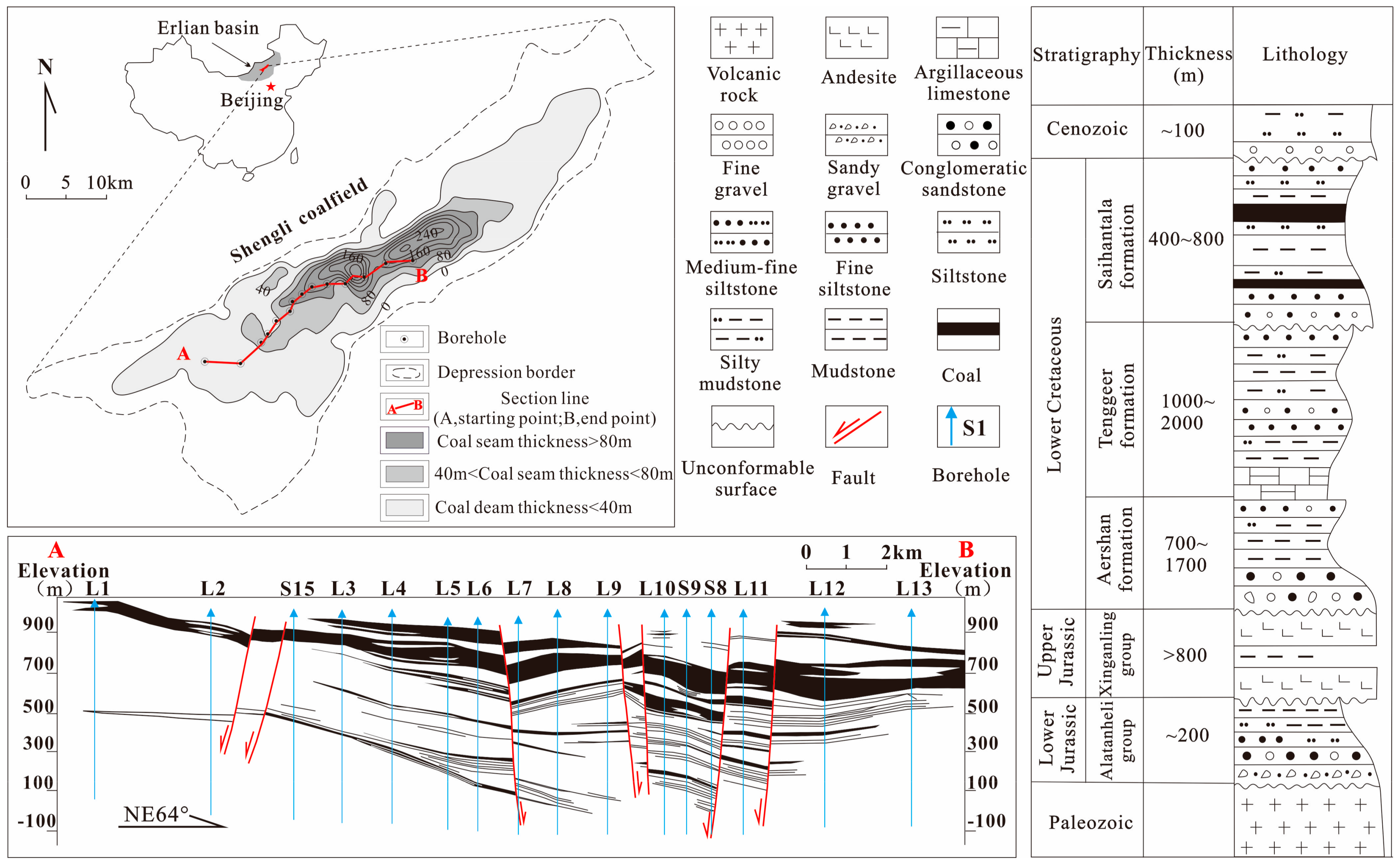

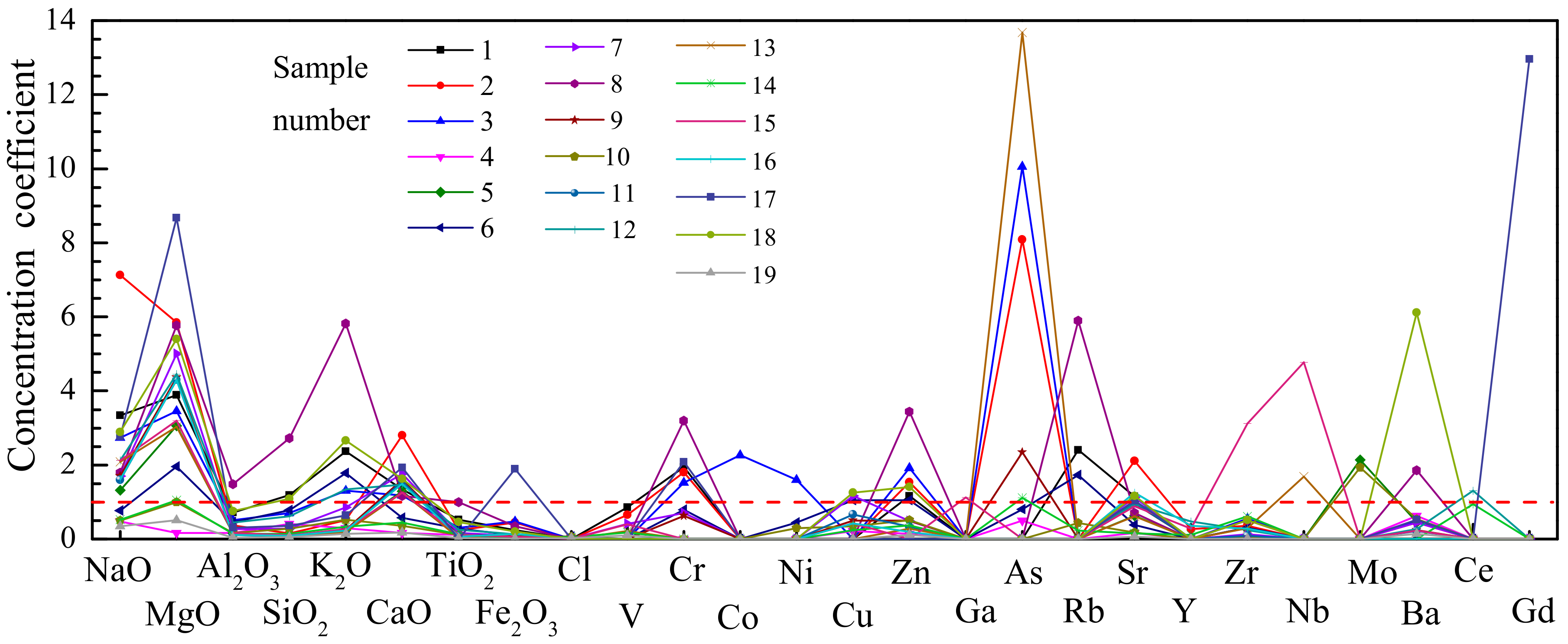


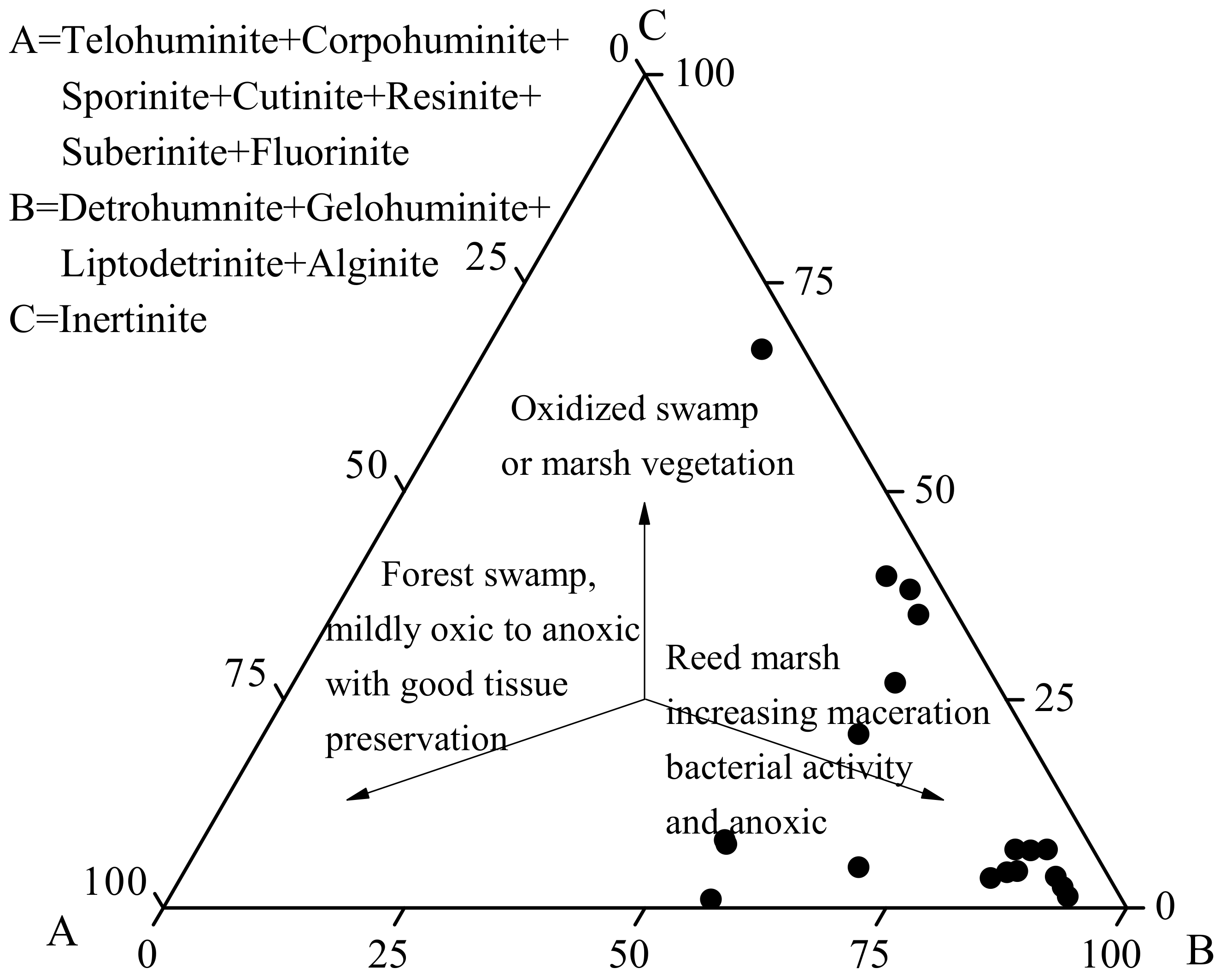
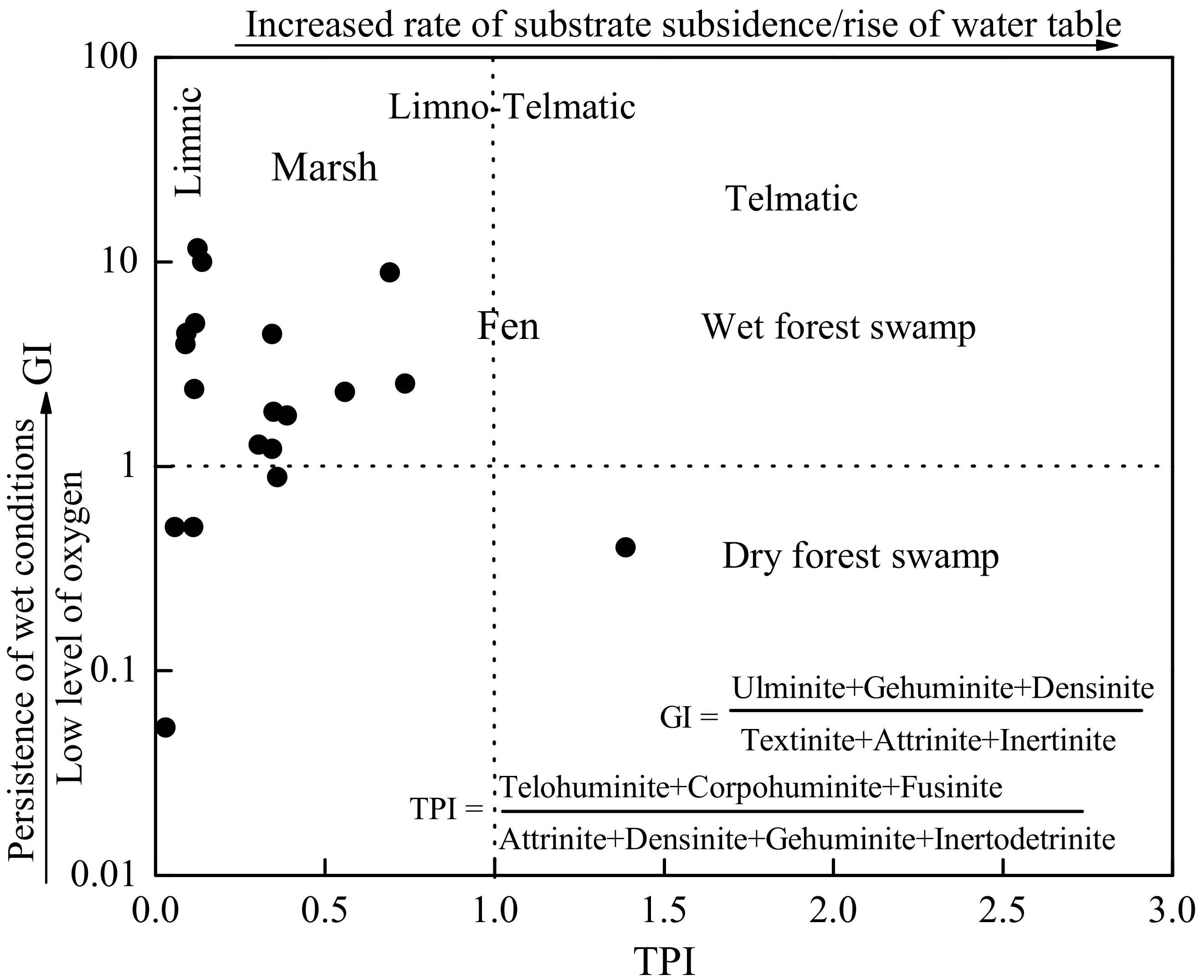
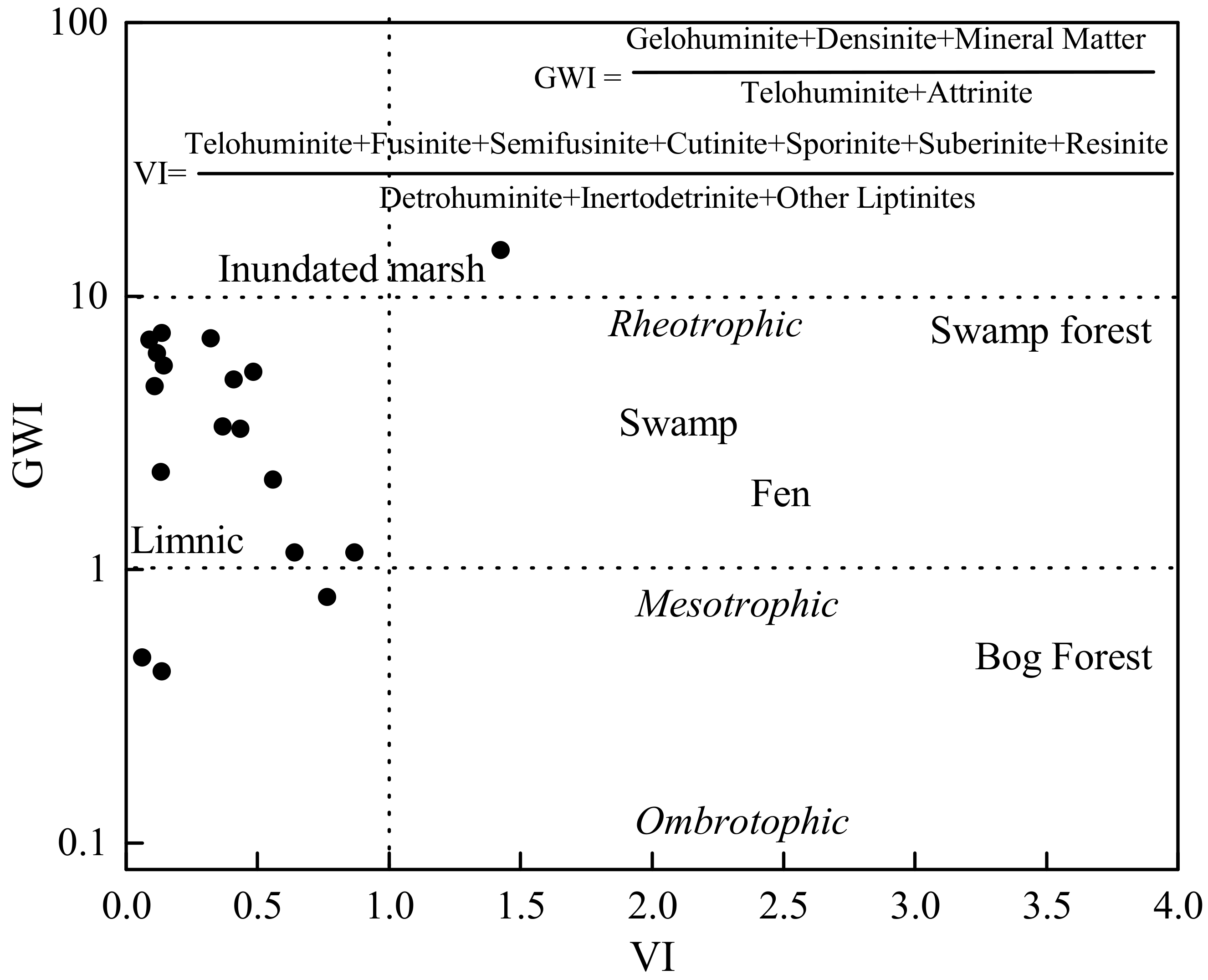


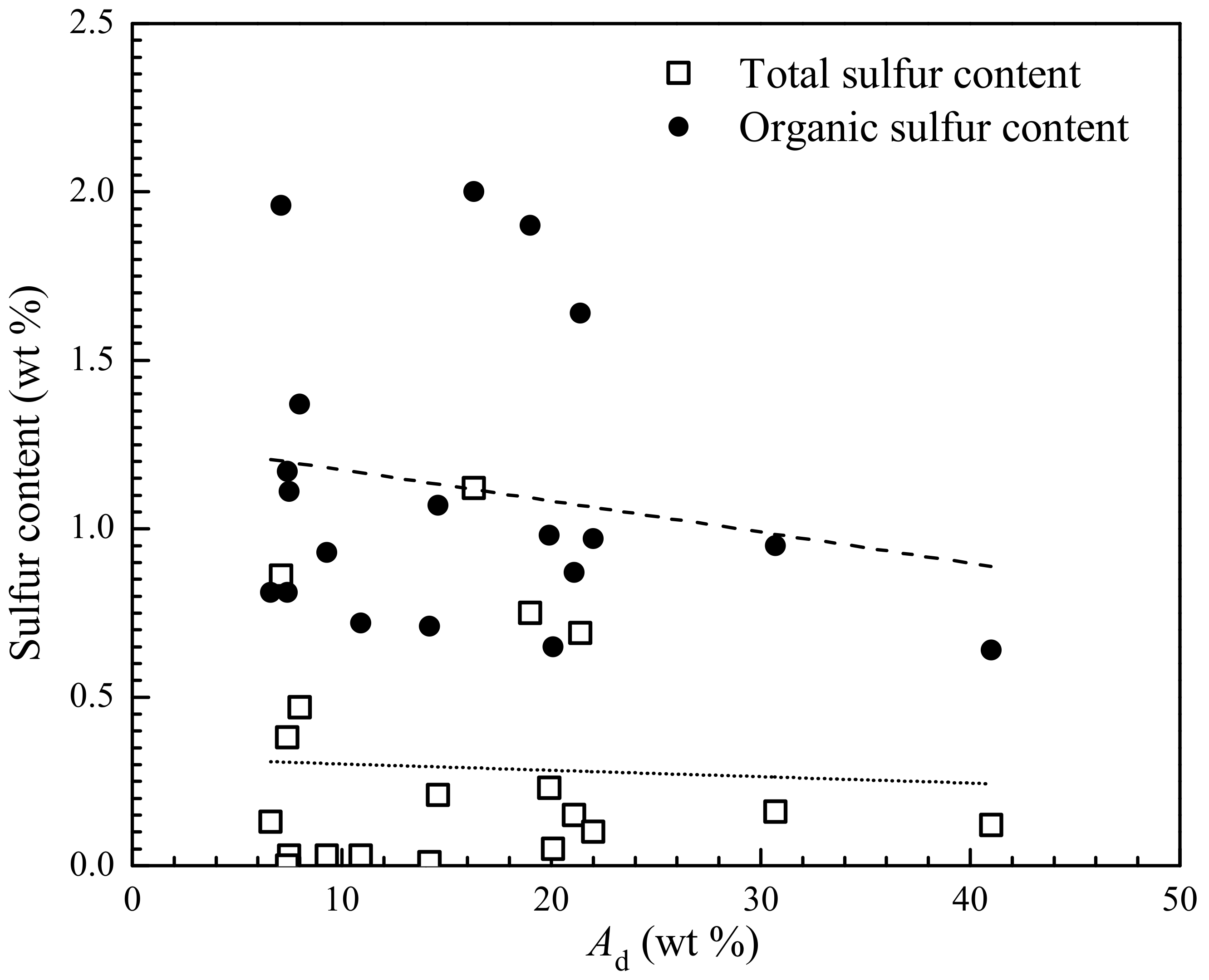
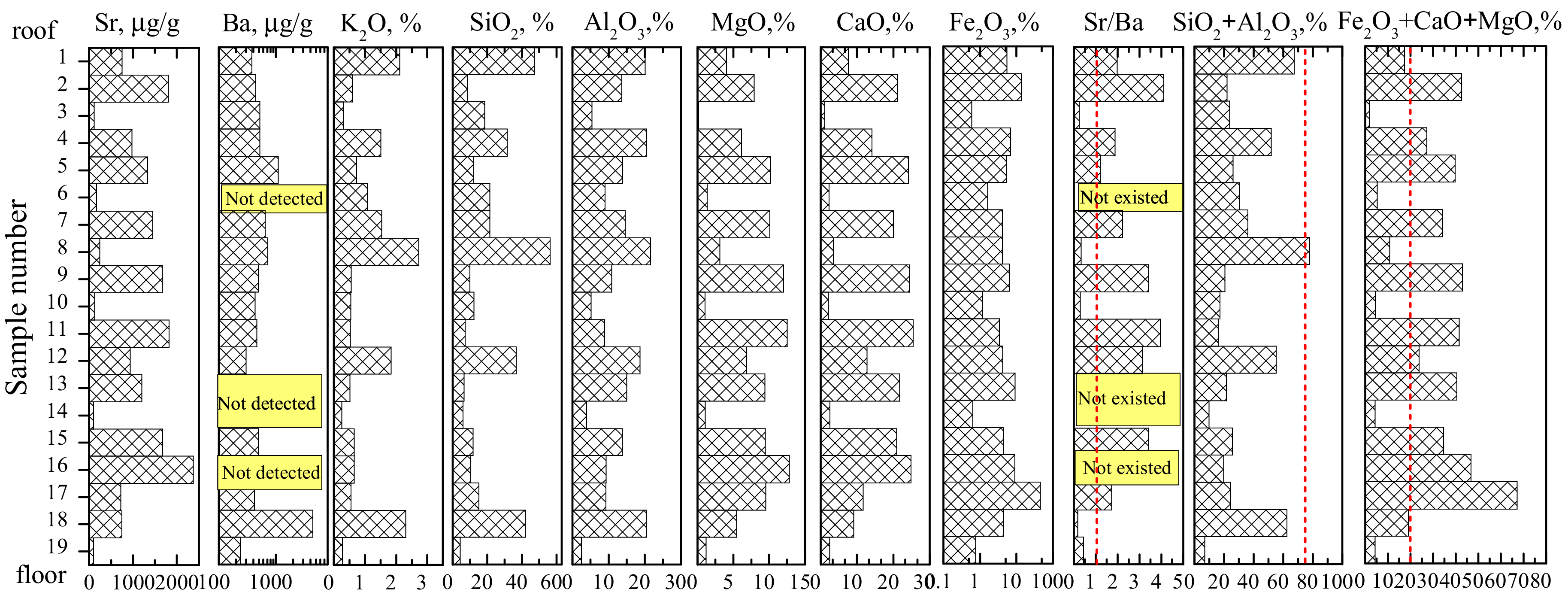
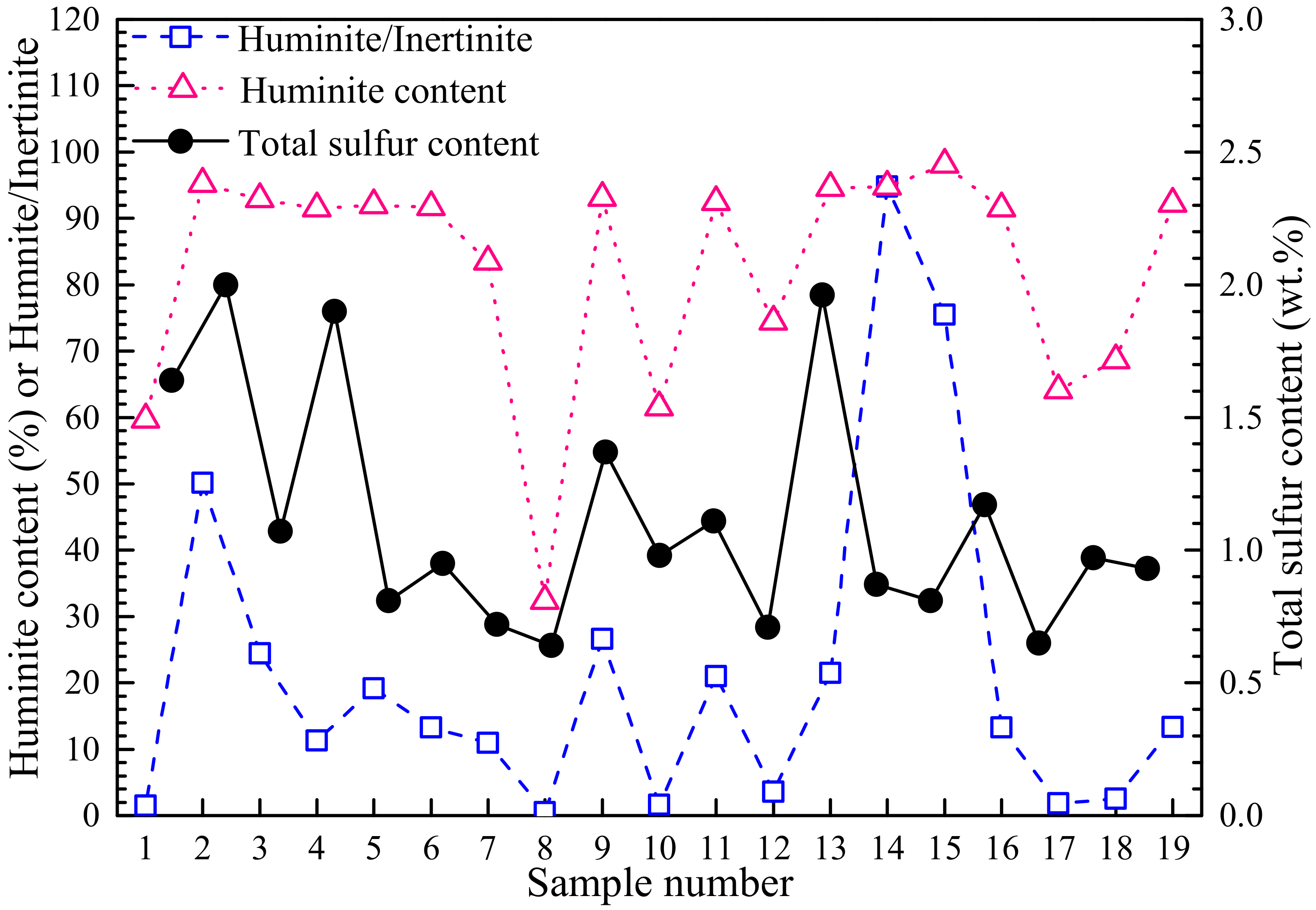




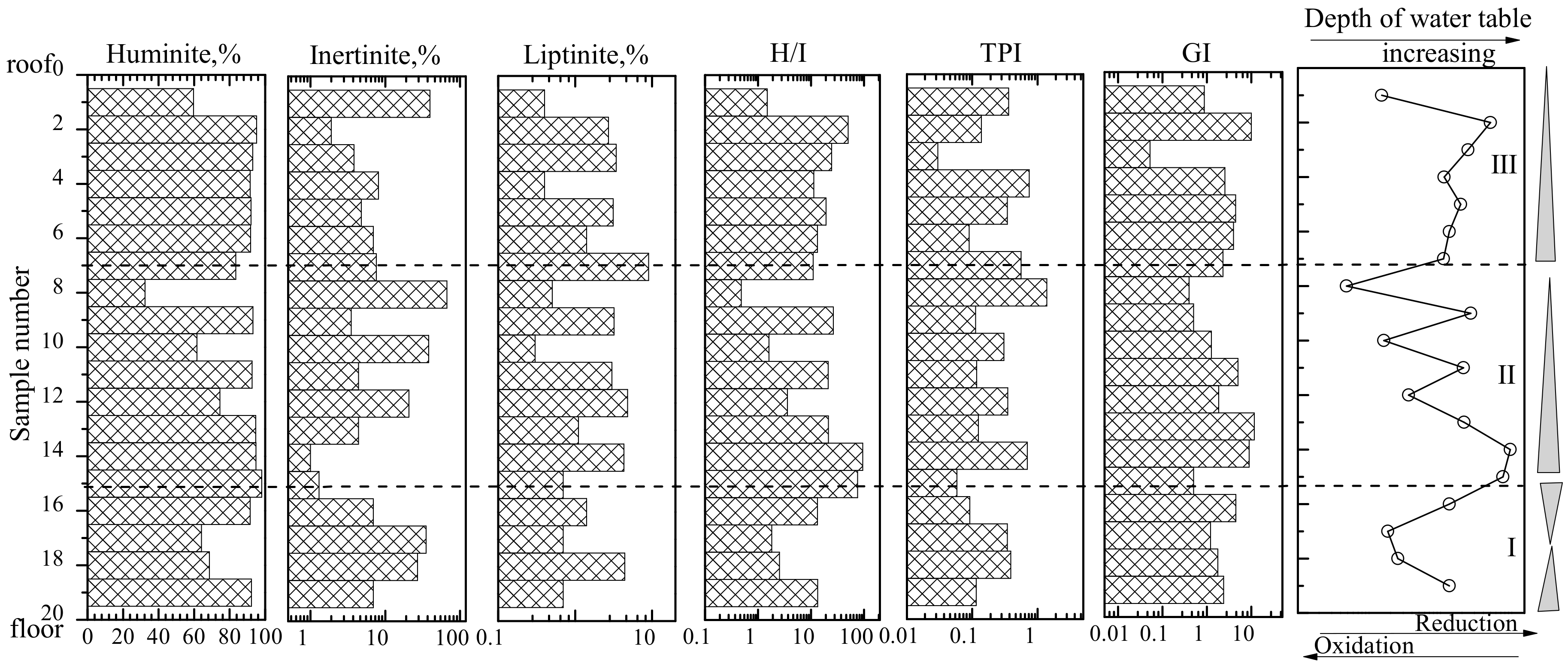
| Sample Number | Proximate Analysis | Sulfur Content | TOC (wt %) | δ13C (‰) | ||||||
|---|---|---|---|---|---|---|---|---|---|---|
| Mad (wt %) | Ad (wt %) | VMdaf (wt %) | FCd (wt %) | St.d (wt %) | Sp.d (wt %) | Ss.d (wt %) | So.d (wt %) | |||
| 1 | 20.1 | 21.4 | 48.0 | 40.9 | 1.64 | 0.69 | 0.08 | 0.87 | 65.22 | −22.88 |
| 2 | 27.0 | 16.3 | 50.9 | 41.1 | 2.00 | 1.12 | 0.07 | 0.81 | 61.91 | −22.07 |
| 3 | 33.5 | 14.6 | 47.0 | 45.2 | 1.07 | 0.21 | 0.03 | 0.83 | 62.67 | −21.83 |
| 4 | 28.4 | 19.0 | 48.7 | 41.6 | 1.90 | 0.75 | 0.15 | 1.00 | 63.32 | −22.04 |
| 5 | 21.1 | 6.6 | 48.6 | 48.0 | 0.81 | 0.13 | 0.05 | 0.63 | 64.00 | −22.04 |
| 6 | 23.2 | 30.7 | 50.8 | 34.1 | 0.95 | 0.16 | 0.08 | 0.71 | 63.75 | −21.99 |
| 7 | 27.9 | 10.9 | 63.4 | 32.6 | 0.72 | 0.03 | 0.04 | 0.65 | 62.75 | −22.66 |
| 8 | 17.8 | 41.0 | 45.4 | 32.2 | 0.64 | 0.12 | 0.05 | 0.47 | 71.69 | −22.13 |
| 9 | 22.8 | 8.0 | 52.5 | 43.7 | 1.37 | 0.47 | 0.06 | 0.84 | 65.02 | −23.42 |
| 10 | 20.6 | 19.9 | 48.2 | 41.5 | 0.98 | 0.23 | 0.08 | 0.67 | 66.19 | −23.34 |
| 11 | 31.2 | 7.5 | 45.7 | 50.2 | 1.11 | 0.03 | 0.03 | 1.05 | 65.96 | −23.36 |
| 12 | 25.4 | 14.2 | 58.9 | 35.3 | 0.71 | 0.01 | 0.03 | 0.67 | 68.87 | −23.07 |
| 13 | 26.6 | 7.1 | 52.3 | 44.4 | 1.96 | 0.86 | 0.15 | 0.95 | 66.05 | −22.52 |
| 14 | 21.6 | 21.1 | 67.6 | 25.6 | 0.87 | 0.15 | 0.03 | 0.69 | 62.48 | −22.67 |
| 15 | 21.3 | 7.4 | 44.6 | 51.3 | 0.81 | 0.00 | 0.00 | 0.81 | 63.30 | −22.18 |
| 16 | 20.2 | 7.4 | 46.9 | 49.2 | 1.17 | 0.38 | 0.05 | 0.74 | 88.64 | −23.12 |
| 17 | 20.1 | 20.1 | 62.1 | 30.3 | 0.65 | 0.05 | 0.03 | 0.57 | 62.03 | −22.64 |
| 18 | 26.9 | 22.0 | 49.0 | 39.8 | 0.97 | 0.10 | 0.08 | 0.79 | 64.11 | −22.28 |
| 19 | 36.5 | 9.3 | 48.6 | 46.6 | 0.93 | 0.03 | 0.00 | 0.90 | 68.15 | −21.92 |
| Average | 24.9 | 16.0 | 51.5 | 40.7 | 1.12 | 0.29 | 0.06 | 0.77 | 66.11 | −22.53 |
| Sample Number | Oxides (%) | Elements (ppm) | |||||||||||||||
|---|---|---|---|---|---|---|---|---|---|---|---|---|---|---|---|---|---|
| Na2O | MgO | Al2O3 | SiO2 | K2O | CaO | TiO2 | Fe2O3 | P | S | Cl | Ti | V | Cr | Mn | Co | Ni | |
| 1 | 2.5 | 4.0 | 20.2 | 47.3 | 2.1 | 7.7 | 0.8 | 5.6 | 210 | 39550 | n.d. | n.d. | 140 | 140 | 210 | n.d. | n.d. |
| 2 | 7.0 | 7.9 | 13.6 | 8.3 | 0.6 | 21.1 | 0.5 | 13.5 | n.d. | 122400 | n.d. | n.d. | 140 | 170 | 322 | n.d. | n.d. |
| 3 | 3.0 | 5.2 | 21.2 | 41.2 | 1.7 | 9.9 | 0.7 | 15.7 | 260 | 53260 | n.d. | n.d. | n.d. | 160 | 240 | 110 | 150 |
| 4 | 0.4 | 0.2 | 5.3 | 18.4 | 0.3 | 1.1 | 0.2 | 0.6 | 517 | 9220 | 140 | n.d. | n.d. | n.d. | 50 | n.d. | n.d. |
| 5 | 3.2 | 10.2 | 13.9 | 12.1 | 0.7 | 24.2 | 0.4 | 5.4 | 470 | 86350 | 130 | n.d. | n.d. | n.d. | 556 | n.d. | n.d. |
| 6 | 0.4 | 1.4 | 9.0 | 21.5 | 1.1 | 2.3 | 0.3 | 1.6 | 210 | 11000 | 180 | n.d. | n.d. | 40 | 80 | n.d. | 20 |
| 7 | 2.5 | 10.1 | 14.6 | 21.5 | 1.5 | 20.0 | 0.5 | 4.1 | 4610 | 74540 | 120 | n.d. | 130 | 100 | 771 | n.d. | n.d. |
| 8 | 0.7 | 3.1 | 21.6 | 56.3 | 2.7 | 3.5 | 0.8 | 4.1 | 310 | 14000 | n.d. | n.d. | n.d. | 120 | 200 | n.d. | n.d. |
| 9 | 3.4 | 12.0 | 10.8 | 9.8 | 0.6 | 24.5 | 0.4 | 6.4 | 500 | 106200 | n.d. | n.d. | n.d. | 120 | 888 | n.d. | n.d. |
| 10 | 0.4 | 1.1 | 5.1 | 12.2 | 0.5 | 2.2 | 0.2 | 1.2 | 210 | 11800 | 280 | n.d. | n.d. | n.d. | 144 | n.d. | 20 |
| 11 | 3.4 | 12.6 | 8.9 | 7.2 | 0.5 | 25.5 | 0.4 | 3.5 | 854 | 116600 | n.d. | n.d. | n.d. | n.d. | 1080 | n.d. | n.d. |
| 12 | 2.4 | 6.9 | 18.7 | 36.7 | 1.8 | 12.8 | 0.6 | 4.2 | 1230 | 53240 | n.d. | n.d. | n.d. | n.d. | 522 | n.d. | n.d. |
| 13 | 4.7 | 9.4 | 15.0 | 6.5 | 0.5 | 21.8 | 0.2 | 9.3 | 400 | 108300 | n.d. | n.d. | 110 | n.d. | 625 | n.d. | n.d. |
| 14 | 0.4 | 1.1 | 4.0 | 5.8 | 0.3 | 2.6 | 0.2 | 0.6 | 180 | 11500 | 210 | n.d. | 30 | n.d. | 80 | n.d. | n.d. |
| 15 | 4.6 | 9.5 | 13.8 | 11.8 | 0.7 | 20.9 | 0.5 | 4.3 | 1050 | 94110 | n.d. | n.d. | 190 | n.d. | 492 | n.d. | n.d. |
| 16 | 3.5 | 12.8 | 9.3 | 10.4 | 0.6 | 24.9 | 0.3 | 9.1 | 1770 | 107700 | 130 | n.d. | n.d. | n.d. | 817 | n.d. | n.d. |
| 17 | 2.2 | 9.5 | 9.2 | 15.1 | 0.6 | 11.8 | n.d. | 45.8 | 6010 | 45440 | n.d. | 1340 | n.d. | 160 | 3810 | n.d. | n.d. |
| 18 | 2.1 | 5.4 | 20.5 | 42.0 | 2.3 | 9.1 | 0.7 | 4.5 | 1210 | 39210 | n.d. | n.d. | n.d. | n.d. | 291 | n.d. | n.d. |
| 19 | 0.6 | 1.2 | 2.5 | 4.4 | 0.3 | 2.4 | 0.1 | 0.8 | n.d. | 12600 | 220 | n.d. | 40 | n.d. | 50 | n.d. | n.d. |
| Sample Number | Elements (ppm) | ||||||||||||||||
| Cu | Zn | Ga | As | Br | Rb | Sr | Y | Zr | Nb | Mo | Ru | Pd | Ba | Ce | Gd | ||
| 1 | n.d. | 225 | n.d. | n.d. | n.d. | 104 | 750 | n.d. | 130 | n.d. | n.d. | n.d. | n.d. | 380 | n.d. | n.d. | |
| 2 | n.d. | 391 | n.d. | 188 | n.d. | n.d. | 1810 | 30 | 195 | n.d. | n.d. | n.d. | 140 | 440 | n.d. | n.d. | |
| 3 | n.d. | 544 | n.d. | 261 | n.d. | n.d. | 1080 | n.d. | 337 | n.d. | n.d. | n.d. | n.d. | 520 | n.d. | n.d. | |
| 4 | 20 | 30 | n.d. | 10 | 20 | n.d. | 122 | n.d. | 31 | n.d. | n.d. | n.d. | n.d. | 520 | n.d. | n.d. | |
| 5 | n.d. | n.d. | n.d. | n.d. | n.d. | n.d. | 1330 | n.d. | n.d. | n.d. | 100 | n.d. | n.d. | 1100 | n.d. | n.d. | |
| 6 | 60 | 141 | n.d. | 10 | n.d. | 52 | 173 | n.d. | 90 | n.d. | n.d. | n.d. | n.d. | n.d. | n.d. | n.d. | |
| 7 | 187 | 185 | n.d. | n.d. | n.d. | n.d. | 1450 | n.d. | 100 | n.d. | n.d. | n.d. | n.d. | 650 | n.d. | n.d. | |
| 8 | n.d. | 347 | n.d. | n.d. | n.d. | 133 | 242 | n.d. | 112 | n.d. | n.d. | n.d. | n.d. | 720 | n.d. | n.d. | |
| 9 | 110 | 258 | n.d. | 111 | n.d. | n.d. | 1670 | n.d. | n.d. | n.d. | n.d. | n.d. | n.d. | 490 | n.d. | n.d. | |
| 10 | 30 | 107 | n.d. | n.d. | n.d. | 20 | 124 | n.d. | 28 | n.d. | 30 | n.d. | n.d. | 430 | n.d. | n.d. | |
| 11 | 154 | 182 | n.d. | n.d. | n.d. | n.d. | 1820 | n.d. | 111 | n.d. | n.d. | n.d. | n.d. | 460 | n.d. | n.d. | |
| 12 | n.d. | n.d. | n.d. | n.d. | n.d. | n.d. | 939 | 60 | 155 | n.d. | n.d. | n.d. | n.d. | 300 | 430 | n.d. | |
| 13 | n.d. | 162 | n.d. | 730 | n.d. | n.d. | 1200 | n.d. | 373 | 225 | n.d. | n.d. | 150 | n.d. | n.d. | n.d. | |
| 14 | 20 | 73 | n.d. | 20 | n.d. | 10 | 105 | 10 | 258 | n.d. | n.d. | 40 | n.d. | n.d. | 210 | n.d. | |
| 15 | 100 | n.d. | 100 | n.d. | n.d. | n.d. | 1673 | 70 | 3782 | 609 | n.d. | n.d. | n.d. | 490 | n.d. | n.d. | |
| 16 | 100 | 110 | n.d. | n.d. | n.d. | n.d. | 2374 | 89 | 348 | n.d. | n.d. | n.d. | n.d. | n.d. | n.d. | n.d. | |
| 17 | n.d. | n.d. | n.d. | n.d. | n.d. | n.d. | 723 | n.d. | n.d. | n.d. | n.d. | n.d. | n.d. | 420 | n.d. | 300 | |
| 18 | 100 | 265 | n.d. | n.d. | n.d. | n.d. | 743 | n.d. | 210 | n.d. | n.d. | n.d. | n.d. | 4420 | n.d. | n.d. | |
| 19 | n.d. | 49 | n.d. | n.d. | n.d. | n.d. | 105 | n.d. | 10 | n.d. | n.d. | n.d. | n.d. | 240 | n.d. | n.d. | |
| Sample Number | Macroscopic Description | Layer Thickness (m) | (%) | Huminite (vol %) | Inertinite (vol %) | Liptinite (vol %) | |||||||||||
|---|---|---|---|---|---|---|---|---|---|---|---|---|---|---|---|---|---|
| Tx | U | At | De | Gh | Ch | Fu | Sf | Ma | Fg | Idt | Sp | Cu | Rs | ||||
| 1 | Dull coal | 1.90 | 0.27 | n.d. | 4.6 | 13.1 | 35.1 | 6.9 | 0.0 | 20.5 | 1.9 | 2.7 | 0.0 | 14.7 | 0.0 | 0.0 | 0.4 |
| 2 | Semidull coal | 2.68 | / | n.d. | 8.2 | 6.5 | 74.3 | 3.1 | 3.1 | 0.3 | 0.3 | 0.0 | 1.0 | 0.3 | 1.7 | 0.3 | 0.7 |
| 3 | Semibright coal | 2.75 | 0.27 | n.d. | 0.3 | 86.4 | 3.1 | 1.4 | 1.7 | 0.7 | 0.0 | 0.0 | 2.4 | 0.7 | 3.1 | 0.0 | 0.3 |
| 4 | Bright coal | 1.00 | / | n.d. | 36.9 | 19.9 | 33.2 | 1.1 | 0.4 | 4.1 | 0.7 | 0.4 | 1.1 | 1.8 | 0.0 | 0.0 | 0.4 |
| 5 | Semibright coal | 0.60 | / | 3.8 | 17.7 | 9.0 | 38.9 | 21.9 | 0.7 | 2.4 | 0.7 | 0.0 | 0.0 | 1.7 | 0.3 | 0.0 | 2.8 |
| 6 | Bright coal | 0.90 | / | n.d. | 4.7 | 13.0 | 73.6 | 0.0 | 0.4 | 2.9 | 0.7 | 1.1 | 0.0 | 2.2 | 0.0 | 0.0 | 1.4 |
| 7 | Semibright coal | 1.40 | / | n.d. | 19.0 | 17.0 | 29.8 | 8.0 | 9.7 | 3.8 | 0.3 | 0.0 | 0.0 | 3.5 | 4.5 | 0.3 | 4.2 |
| 8 | Dull coal | 0.65 | / | n.d. | 2.7 | 3.2 | 24.3 | 1.1 | 1.1 | 52.4 | 0.5 | 2.2 | 0.0 | 11.9 | 0.0 | 0.0 | 0.5 |
| 9 | Bright coal | 0.57 | / | n.d. | 6.1 | 58.9 | 14.2 | 11.0 | 2.9 | 0.3 | 0.3 | 0.0 | 2.9 | 0.0 | 3.2 | 0.0 | 0.0 |
| 10 | Dull coal | 0.62 | 0.29 | n.d. | 2.4 | 5.4 | 50.0 | 3.0 | 0.7 | 19.9 | 0.7 | 0.7 | 0.0 | 16.9 | 0.0 | 0.0 | 0.3 |
| 11 | Bright coal | 0.26 | / | n.d. | 0.3 | 10.8 | 73.0 | 2.7 | 5.7 | 4.1 | 0.0 | 0.0 | 0.3 | 0.0 | 1.0 | 0.0 | 2.0 |
| 12 | Dull coal | 0.21 | 0.26 | n.d. | 6.3 | 10.4 | 45.1 | 6.3 | 6.3 | 11.1 | 0.3 | 2.4 | 1.0 | 5.9 | 2.4 | 0.0 | 2.4 |
| 13 | Semidull coal | 0.07 | / | n.d. | 8.5 | 3.5 | 78.7 | 3.2 | 0.7 | 1.4 | 0.4 | 1.1 | 1.1 | 0.4 | 0.4 | 0.0 | 0.7 |
| 14 | Semibright coal | 0.20 | / | n.d. | 36.4 | 8.5 | 39.0 | 8.9 | 2.0 | 0.7 | 0.0 | 0.3 | 0.0 | 0.0 | 2.3 | 0.0 | 2.0 |
| 15 | Bright coal | 0.19 | 0.28 | n.d. | 4.1 | 64.2 | 23.7 | 5.4 | 0.7 | 0.7 | 0.0 | 0.0 | 0.3 | 0.3 | 0.7 | 0.0 | 0.0 |
| 16 | Semibright coal | 0.57 | / | n.d. | 3.3 | 11.0 | 75.7 | 1.5 | 0.0 | 4.8 | 0.7 | 0.7 | 0.0 | 0.7 | 0.7 | 0.0 | 0.7 |
| 17 | Dull coal | 0.50 | 0.27 | n.d. | 2.9 | 9.5 | 50.9 | 0.4 | 0.4 | 18.7 | 3.7 | 9.9 | 0.0 | 2.9 | 0.0 | 0.0 | 0.7 |
| 18 | Seimdull coal | 0.49 | / | n.d. | 4.1 | 6.8 | 53.7 | 2.0 | 2.0 | 19.6 | 3.0 | 0.7 | 0.0 | 3.7 | 2.4 | 0.0 | 2.0 |
| 19 | Bright coal | 1.20 | 0.27 | n.d. | 7.3 | 22.4 | 61.5 | 1.0 | 0.0 | 2.8 | 0.7 | 0.3 | 0.0 | 3.1 | 0.0 | 0.0 | 0.7 |
| Average | 0.88 | 0.27 | 0.2 | 9.3 | 20.0 | 46.2 | 4.7 | 2.0 | 9.0 | 0.8 | 1.2 | 0.5 | 3.7 | 1.2 | 0.0 | 1.2 | |
| Botanical Affinities | Sample Number | 3 | 5 | 8 | 10 | 12 | 17 | 18 | ||
|---|---|---|---|---|---|---|---|---|---|---|
| Bryophyte | Sphagnumsporites sp. | 1 | 1 | |||||||
| Polycingulatisporites retundus | 1 | |||||||||
| Kuylisporites lunaris | 1 | |||||||||
| Foraminisporis asymmetricus | 1 | 1 | ||||||||
| Foraminisporis wonthaggiensis | 1 | |||||||||
| Pteridophyta | Lycopodiales | Lycopodiumsporites paniculatoides | 1 | |||||||
| Lycopodiumsporites tenellus | 1 | |||||||||
| Lycopodiumsporites reticulumsporites | 1 | |||||||||
| Selaginellaceae | Neoraistrickia rotundiformis | 1 | 1 | 1 | ||||||
| Densoisporites sp. | 1 | |||||||||
| Bayanhuasporites membranceus | 2 | 1 | 1 | |||||||
| Cyatheaceae | Leiotriletes sp. | 18 | 1 | 6 | 1 | |||||
| Cyathidites minor | 20 | 1 | 32 | 13 | 1 | 2 | 2 | |||
| Deltoidopsora triangularis | 12 | 3 | ||||||||
| Osmundaceae | Osmundacidites wellmanii | 2 | 2 | 3 | ||||||
| Osmundacidites sp. | 1 | 2 | 1 | |||||||
| Todisporites minor | 1 | |||||||||
| Gleicheniaceae | Gleicheniidites senoicus | 11 | 1 | 2 | ||||||
| Lygodiaceae | Cicatricosisporites minor | 10 | 1 | 1 | ||||||
| Cictricosisporites australiensis | 9 | 1 | 1 | |||||||
| Cicatricosisporites amalocostriatus | 3 | 1 | ||||||||
| Cicatricosisporites mimutaestriatus | 9 | |||||||||
| Cicatricosisporites sp. | 3 | |||||||||
| Lygodioisporites perverrucatus | 3 | |||||||||
| Polypodiaceae | Laevigatosporites ovatus | 7 | 2 | 4 | 3 | 1 | ||||
| Unclear Botanical affinities | Apiculatisporis parvispinosus | 2 | ||||||||
| Sphaerina wulinensis | 1 | |||||||||
| Granulatisporites sp. | 1 | |||||||||
| Leptolepidites psarosus | 2 | 5 | 2 | 1 | ||||||
| Dictyotriletes speciosus | 2 | 1 | ||||||||
| Gymnospermae | Cycads and ginkgo | Cycadopites acerrimus | 1 | 2 | 1 | |||||
| Cycadopites sp. | 5 | 3 | 5 | 1 | ||||||
| Chasmatosporites minor | 1 | 1 | ||||||||
| Eucommiidites troedsoni | 3 | 2 | 1 | |||||||
| Conifers | Pseudofrenelopsis | Classopollis annulatus | 7 | 6 | 3 | 1 | 3 | |||
| Cupressaceae | Spheripollenites psilatus | 1 | 1 | |||||||
| Caytoniales | Caytonipollenites pallidus | 1 | ||||||||
| Pinaceae | Protoconiferus sp. | 1 | 1 | |||||||
| Pseudopicea sp. | 1 | |||||||||
| Piceites sp. | 1 | |||||||||
| Pinuspollenites spp. | 8 | 3 | 17 | 15 | 3 | 6 | 4 | |||
| Piceaepollenites spp | 3 | 5 | 4 | 5 | 2 | |||||
| Pityosporites similis | 6 | |||||||||
| Parvisaccites radiatus | 1 | 2 | ||||||||
| Podocarpaceae | Podocarpidites sp. | 1 | 1 | |||||||
| Unclear Botanical affinities | Perinopollenites granulatus | 1 | 1 | 1 | ||||||
| Unidentified non-rib bisaccate pollen | 2 | 8 | 5 | 9 | 2 | 5 | ||||
| Algae | Concentricystes sp. | 1 | ||||||||
| Bryophyte counting | 4 | 2 | 1 | |||||||
| Pteridophyta counting | 118 | 7 | 59 | 29 | 7 | 2 | 3 | |||
| Gymnospermaecounting | 27 | 7 | 46 | 31 | 31 | 16 | 15 | |||
| Total counting | 149 | 14 | 105 | 63 | 38 | 18 | 19 | |||
| Spore-Pollen Category | Number of the Sample | Climate Signal | ||||||
|---|---|---|---|---|---|---|---|---|
| 3 | 5 | 8 | 10 | 12 | 17 | 18 | ||
| Leiotriletes sp. | 12.08 | Warm and Wet | ||||||
| Cyathidites minor | 13.42 | 30.48 | 20.63 | 11.11 | 10.53 | Warm and wet | ||
| Laevigatosporites ovatus | 14.29 | Hot and wet | ||||||
| Cycadopites sp. | 13.16 | Hot and wet | ||||||
| Classopollis annulatus | 15.79 | Hot and dry | ||||||
| Pinuspollenites spp. | 21.43 | 16.19 | 23.81 | 33.33 | 21.05 | Warm and semiarid | ||
| Piceaepollenites spp | 21.43 | 10.53 | 27.78 | 10.53 | Warm and semiarid | |||
| Unidentified non-rib bisaccate pollen | 23.68 | 11.11 | 26.32 | Unknown | ||||
© 2018 by the authors. Licensee MDPI, Basel, Switzerland. This article is an open access article distributed under the terms and conditions of the Creative Commons Attribution (CC BY) license (http://creativecommons.org/licenses/by/4.0/).
Share and Cite
Shen, J.; Qin, Y.; Wang, J.; Shen, Y.; Wang, G. Peat-Forming Environments and Evolution of Thick Coal Seam in Shengli Coalfield, China: Evidence from Geochemistry, Coal Petrology, and Palynology. Minerals 2018, 8, 82. https://doi.org/10.3390/min8030082
Shen J, Qin Y, Wang J, Shen Y, Wang G. Peat-Forming Environments and Evolution of Thick Coal Seam in Shengli Coalfield, China: Evidence from Geochemistry, Coal Petrology, and Palynology. Minerals. 2018; 8(3):82. https://doi.org/10.3390/min8030082
Chicago/Turabian StyleShen, Jian, Yong Qin, Jinyue Wang, Yulin Shen, and Geoff Wang. 2018. "Peat-Forming Environments and Evolution of Thick Coal Seam in Shengli Coalfield, China: Evidence from Geochemistry, Coal Petrology, and Palynology" Minerals 8, no. 3: 82. https://doi.org/10.3390/min8030082





